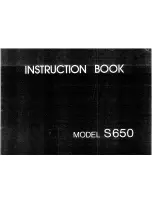
A
D
B
C
1
2
Getting Ready to Sew – 9
CHANGING THE PRESSER FOOT
Press the ON/OFF switch to OFF.
1. Make sure the needle is in the highest position and the
presser foot is lifted. Pull the presser foot towards you.
2. Line up the cross pin on the foot with the gap in the
presser foot ankle. Push back until the foot snaps into
place.
CHANGING THE NEEDLE
Press the ON/OFF switch to OFF.
1. Use the hole in the multipurpose tool to hold the needle.
2. Loosen the screw in the needle clamp with the
screwdriver.
3. Remove the needle.
4. Insert the new needle using the multipurpose tool.
With the fl at side away from you, push the new needle
upwards until it will go no further.
5. Use the screwdriver to tighten the screw.
NEEDLES
The sewing machine needle plays an important role in
successful sewing. To ensure you will get a quality needle,
we recommend needles of system 130/705H. The needle
package included with your machine contains needles of
the most frequently used sizes for sewing on woven and
stretch fabrics.
Universal needle (A)
Universal needles have a slightly rounded point and come in
a variety of sizes. For general sewing in a variety of fabric
types and weights.
Stretch needle (B)
Stretch needles have a special scarf to eliminate skipped
stitches when there is a fl ex in the fabric. For knits,
swimwear, fl eece, synthetic suedes and leathers. Marked
with a yellow band.
Denim needle (C)
Denim needles have a sharp point to penetrate tightly
woven fabrics without defl ecting the needle. For canvas,
denim, microfi bers. Marked with a blue band.
Wing needle (D)
The Wing needle has wide wings on the side of the needle
to poke holes in the fabric when sewing entredeux and
other hemstitches on natural fi ber fabrics.
Note: Change the needle often. Always use a straight needle with a
sharp point (1). A damaged needle (2) can cause skipped stitches,
breakage of needles or snapping of thread. A damaged needle can
also damage the stitch plate.










































